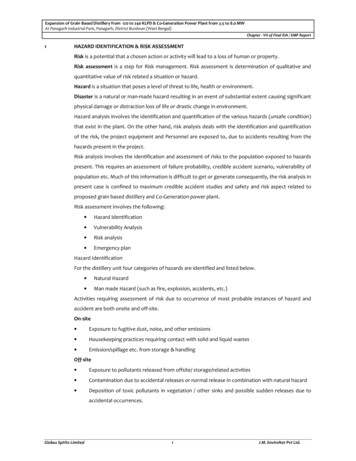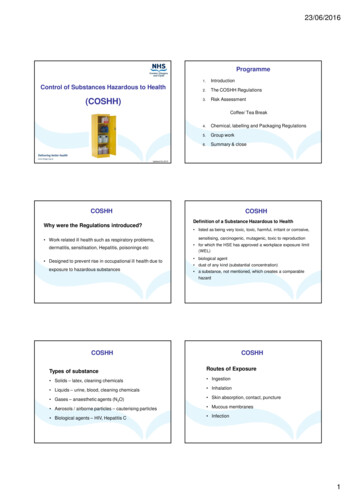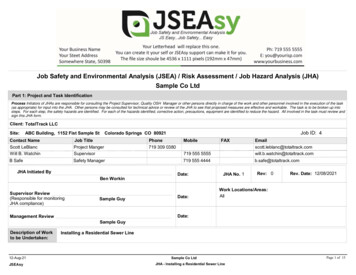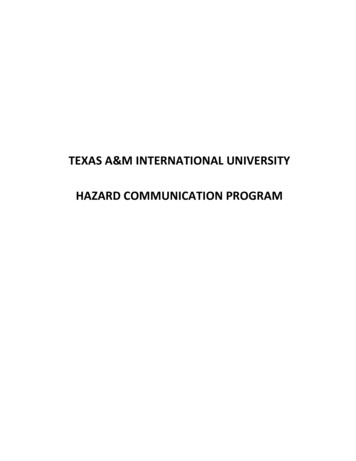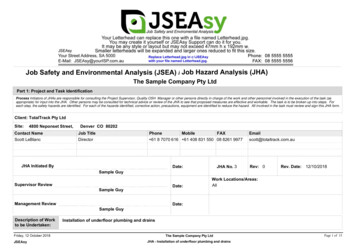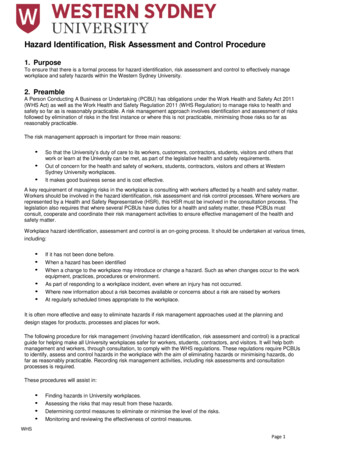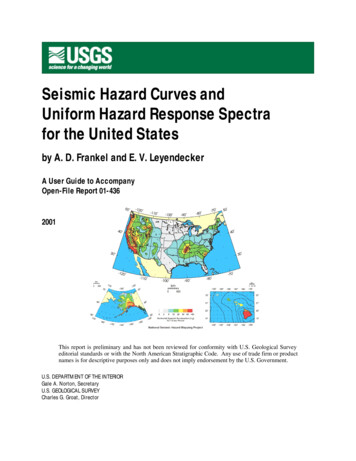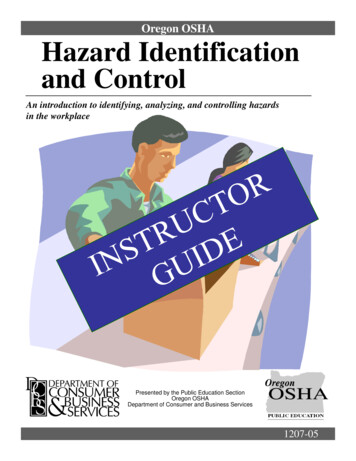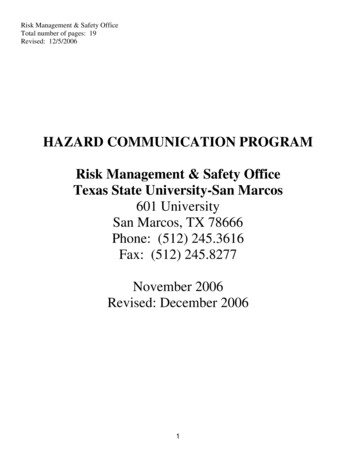
Transcription
Risk Management & Safety OfficeTotal number of pages: 19Revised: 12/5/2006HAZARD COMMUNICATION PROGRAMRisk Management & Safety OfficeTexas State University-San Marcos601 UniversitySan Marcos, TX 78666Phone: (512) 245.3616Fax: (512) 245.8277November 2006Revised: December 20061
Risk Management & Safety OfficeTotal number of pages: 19Revised: 12/5/2006INDEX1.General Information2.Exemptions3.Definitions4.Workplace Chemical List5.Material Safety Data Sheets6.Chemical Container Labels7.Employee Training Program8.Reporting Employee Deaths and Injuries9.Posting the Notice to Employees10.Personal Protective Equipment11.Maintaining Employee Rights12.AttachmentsA. Workplace Chemical ListB. Employee Training RosterC. Employee Training SheetD. Notice to Employee (English version)E. Notice to Employee (Spanish version)2
Risk Management & Safety OfficeTotal number of pages: 19Revised: 12/5/20061. General Information1.1. The Texas Hazard Communication Act (THCA), codified as Chapter 502 of the TexasHealth and Safety Code (HSC), requires all public employers in Texas to provide their employees withinformation regarding hazardous chemicals to which employees may be exposed in their workplace. In orderto comply with Section 502.009(b) of the THCA and Section 295.7(a) of the THCA Rules (Title 25 of theTexas Administrative Code (TAC), Section 295.1- 295.12), the following written Hazard CommunicationProgram has been established for Texas State University-San Marcos.1.2. The master copy of the written hazard communication program will be maintained by the RiskManagement & Safety Office and can be accessed at http://www.vpfss.txstate.edu/riskmgt/. Copies of thewritten program will be modified as needed for each separate work area where hazardous chemicals are usedor stored. A copy may also be maintained at each work area. The written program will be available to allinterested employees and their representatives upon request.1.3. To facilitate administration of and compliance with this Program, the following levels of responsibilityhave been established:1.3.1. Risk Management and Safety Office (RMSO) - with regard to the university’s hazardcommunication program, the RMSO has the following responsibilities:1.3.1.1. Compilation and review of the departmental Work Area Chemical Lists (WACL) to comprisethe University’s Workplace Chemical List (WPCL). The WPCL shall be updated throughout the yearas additional hazardous chemicals are introduced in departments. The WPCL shall be maintained bythe employer (Texas State) for thirty (30) years from WPCL preparation date. The RMSO isdesignated as the office of record to meet this responsibility.1.3.1.2. Preparation and submission of the annual Texas Tier Two Report and filing fee to the TexasDepartment of State Health Services of Health (TDSHS). Provide the Local Emergency PlanningCommittee (LEPC) and the San Marcos Fire Department (SMFD) with a copy of the Texas Tier TwoReport.1.3.1.3. Orientation briefings for staff and faculty, including employees’ rights under the THCA, at theNew Employee Orientation scheduled by the Human Resources office and New Faculty Orientationscheduled by the Faculty Advancement Center.1.3.1.4. Dissemination of the “Notice to Employees” to apprise them of their rights under the THCA,as listed in Attachments D (English) & E (Spanish): (See Also Section 9)1.3.1.5 Reporting Employee Accidents – All accidents resulting in death or the hospitalization of fiveor more employees must be reported to TDSHS, Division for Regulatory Services Enforcement Unit asit relates to hazardous chemical exposure or asphyxiation. (See Section 8)1.3.2. Department heads/account managers and all employees identified as having supervisory controlover other employees of the University are responsible for their employees’ safety and well-being. Withregard to this Program, their responsibilities include, but are not limited to, the following:3
Risk Management & Safety OfficeTotal number of pages: 19Revised: 12/5/20061.3.2.1. Written Training Program (Attachment C) - Develop and implement a written hazardcommunications training program to address the use of hazardous chemicals in their work areas. SeeSection 12.3 for program format.1.3.2.2. Employee Rights - Post the "Notice to Employee" poster in the work area, Attachments D(English) & E (Spanish): (Also see Section 9).1.3.2.3. Departmental Work Area Chemical List - Compile a Work Area Chemical List (WACL), notlater than December 31 of each year. The WACL must be readily available in the work area and acopy of the list must be furnished to the RMSO, upon request. Although the WACL does not apply toresearch & teaching laboratories (See Section 2.1.2), it is the practice of Texas State University-SanMarcos to maintain WACL to better facilitate accurate MSDS files. (See Section 4)1.3.2.4. Departmental MSDSs - provide MSDS data in the work area for each chemical listed on theWACL. The MSDS will be readily available for review by employees. (See Section 5)1.3.2.5. Chemical Container Labels – ensure that all chemical labels have not been defaced in anyway;all secondary containers are properly labeled (See Section 6)1.3.2.6. Departmental Training - New and newly-assigned employees, including student workers, mustbe provided an orientation training session before they are allowed to work with, or in, a work areacontaining hazardous chemicals. (See Section 7)1.3.2.7. Reporting all hazardous chemical accidents (See Section 8)1.3.2.8. Provide their employees and/or students with appropriate personal protective equipment (PPE)for the hazardous chemicals in use. (See Section 10)1.3.2.9. Account managers who contract for services for the University that are provided on campusmust ensure the contractor has a written Hazard Communication Program to cover their employeeswho will be working at the university job site. Account managers who contract for such services mustassure that their contracts with vendors contain wording to meet the requirements of the THCA. AWACL with associated MSDS’s must be maintained by the contractor at the university job site and bereadily available upon request to university personnel. Failure to provide such information mayconstitute grounds for termination of the contractor.1.3.2.10 Appoint an official “Hazard Communication Act (HCA) contact” for each hazardous workarea.1.3.3. Departmental HCA contact in each work area is responsible for: acting as liaison with the RMSO;maintaining department Hazard Communication Plan (HCP), WACL, reporting accidents and MSDSrecords; and ensuring that new employees are provided training before working with hazardouschemicals.4
Risk Management & Safety OfficeTotal number of pages: 19Revised: 12/5/20062. Exemptions - Per Section 502.004(f), the following chemicals are exempt from the requirements of theTHCA and are outside the scope of this written program:2.1. Hazardous waste that is subject to regulation by the Texas Commission on Environmental Quality and/orthe U.S. Environmental Protection Agency2.2. A chemical in a laboratory under the direct supervision or guidance of a technically qualifiedindividual if:2.2.1. Labels on incoming containers of chemicals are not removed or defaced2.2.2. This employer complies with Sections 502.006 (“MSDS”) and 502.009 (“Employee EducationProgram”) of the THCA with respect to laboratory employees; and2.2.3. The laboratory is not used primarily to produce hazardous chemicals in bulk for commercialpurposes2.3. Tobacco or tobacco products2.4. Wood or wood products2.5. Articles formed to a specific shape or design during manufacture and that does not release or otherwiseresult in exposure to a hazardous chemical under normal conditions of use2.6. Food, drugs, cosmetics or alcoholic beverages2.7. Consumer products or hazardous substances used in the workplace in the same manner as normalconsumer use and if the use results in a duration and frequency of exposure that is not greater than exposuresexperienced by a consumer2.8. Radioactive waste3. Definitions3.1. “Appropriate Hazard Warning” – Any words, pictures, symbols, or combination thereof appearing ona label or other appropriate form of warning which convey the health and physical hazards, including thetarget organ effects, of the chemical(s) in the container(s).3.2. “Categories of Hazardous Chemicals” – A grouping of hazardous chemicals with similar properties.3.3. “Container” – Any bag, barrel, bottle, box, can, cylinder, drum, reaction vessel, storage tank, or the likethat contains a hazardous chemical or contains multiple smaller containers of an identical hazardouschemical. The term “container” does not mean pipes or piping systems, nor does it mean engines, fuel tanks,or other operating systems in a vehicle. A primary container is one in which the hazardous chemical isreceived from the supplier. A secondary container is one to which the hazardous chemical is transferredafter receipt from the supplier.5
Risk Management & Safety OfficeTotal number of pages: 19Revised: 12/5/20063.4. “Employee” – Those full-time or part-time, faculty, staff and student workers whose compensation isprovided, controlled or dispensed by the University and who may be or may have been exposed to hazardouschemicals in the person’s workplace under normal operating conditions or foreseeable emergencies. Note:As a matter of preference the University will also begin to include students who may be exposed tohazardous chemicals in the student’s workplace under normal operating conditions or foreseeableemergencies. While this is not a regulation, the RMSO feels that it is in the best interest of the Universityand the students to provide safety training at the beginning of each semester in each laboratory.3.5. “Expose” – Subjecting an employee to a hazardous chemical in the course of employment through anyroute of entry, including inhalation, ingestion, skin contact, or absorption. The term includes potential,possible, or accidental exposure under normal conditions of use or in a reasonable foreseeable emergency.3.6. “Hazardous Chemical” or “Chemical” – An element, compound, or mixture of elements orcompounds that is a physical hazard or a health hazard regardless of its form.3.7. “Health Hazard” – A chemical for which there is statistically significant evidence based on at least onestudy conducted in accordance with established scientific principles that acute or chronic health effects mayoccur in exposed employees and a chemical which is a toxic agent, irritant, corrosive, or sensitizer.3.8. “Label” – Any written, printed, or graphic material displayed on or affixed to containers of hazardouschemicals, and which includes the same name as on the material safety data sheet.3.9. “Material Safety Data Sheet” (“MSDS”) – A document containing chemical hazard and safe handlinginformation that is prepared in accordance with the requirements of the federal Occupational Safety andHealth Administration (OSHA) standard for that document. A current MSDS is one which contains themost recent significant hazard information for the hazardous chemicals as determined by the chemical’smanufacturer. An appropriate MSDS is one which conforms to the most current requirements set byOSHA standards.3.10. “Physical Hazard” – A chemical for which there is scientifically valid evidence that it is acombustible liquid, a compressed gas, explosive, flammable, an organic peroxide, an oxidizer, pyrophoric,unstable (reactive), or water-reactive.3.11. “Personal Protective Equipment” – Protective equipment provided to an employee by the employerwhich provides a level of protection to chemicals to which the employee may be exposed that will beadequate to ensure their health and safety based on current industry standards.3.12. “Stationary Process Container” – A tank, vat, or other such container which holdsdifferent hazardous chemicals at different times.3.13. “Technically Qualified Individual” – An individual with a professional education and backgroundworking in the research or medical fields, such as a physician or registered nurse, or an individual holding aminimum of a bachelor’s degree in a physical or natural science. Professors and those working under theirdirect supervision easily qualify.6
Risk Management & Safety OfficeTotal number of pages: 19Revised: 12/5/20063.14. “Work Area” – A room, department, section, studio lab, defined space, utility structure, or emergencyresponse site in a workplace where hazardous chemicals are present, produced, or used, and whereemployees are present.3.15. “Workplace” – A contiguous facility that is staffed 20 hours or more per week, unless such a facilityis subdivided by the employer. Normally this subdivision would be a building, cluster of buildings or otherstructures, or a complex of buildings, but could be for a portion of a building if the employer chooses.Noncontiguous properties are always separate workplaces unless they are temporary workplaces, in whichcase they can be either work areas of a headquarters’ workplace or separate workplaces, which is at thediscretion of the employer.3.16. “Extremely Hazardous Substance (EHS)” – material determined by the Environmental ProtectionAgency (EPA) to be potentially hazardous to life and health if released. EHS’s are listed in 40 CFR 355(Appendices A and B) and available online abetical Results!OpenView&Start 13.17. “Hazard Communication Program” – A written program that describes how the elements of theprogram will be met in the workplace and work areas. This program will include element required by TexasHazard Communication Act.3.18. “Local Emergency Planning Committee (LEPC) – A committee formed under the EmergencyPlanning and Community Right to Know Act (EPCRA) section 301, and recognized by the State EmergencyResponse Commission for the purposes of emergency planning and public information. The University iscovered by the Hays County LEPC.3.19. “Penalties” – Sums of money prescribed by the THCA which constitute administrative penalties andcivil or criminal fines. These may range from 50 to 100,000 for each violation of the THCA.3.20. “Texas Tier Two Report” – An annual report required to be sent to TDSHS on hazardous chemicalsand extremely hazardous chemicals above the threshold reporting level. Copies of the report are madeavailable to the LEPC and local fire department (San Marcos Fire Department)3.21. “Work Area Chemical List (WACL)” – A list of specific chemicals in use or stored in each workarea. The list contains chemical name, common name, storage location, manufacturer/distributor name,catalog number pertaining to the chemical name, and quantity in use or storage3.22. “Workplace Chemical List (WPCL)” – A consolidation of all work area chemical lists (non-exempt)will comprise the University WPCL.3.23. “Chemical Inventory” – A comprehensive list of chemicals that are a part of the workplace. Thisexcludes office supplies that may be of a chemical nature.3.24. “University” – A reference to Texas State University-San Marcos3.25. “Chemical Hygiene Plan (CHP)” – A lab safety plan that presents the recommendations of the RMSIfor the use of chemicals in laboratories at the University. All personnel involved in laboratory research7
Risk Management & Safety OfficeTotal number of pages: 19Revised: 12/5/2006efforts or teaching should be familiar with this document and the protocols which pertain to their work.Every employee is responsible to ensure these procedures are followed.4. Workplace Chemical List. . (HSC §502.005 and 25TAC §295.4)4.1. The Risk Management and Safety Office (RMSO) will develop and maintain a list of hazardouschemicals normally present in the workplace in excess of 55 gallons or 500 pounds. This WorkplaceChemical List will be developed for where such quantities of hazardous chemicals are used or stored and willbe available for review by employees and their designated representatives. This WPCL is a compilation ofall WACL. (See Attachment A, Model Workplace Chemical List) Each work area can use this same form.4.1.1. Work Area Chemical Lists (WACL) are compiled by not later than December 31 of each year. TheWACL must be readily available in the work area and a copy must be furnished to RMSO upon request.Research laboratories are exempt from this process (See Section 2); however, as a matter of practiceRMSO highly recommends that each work area maintain a working chemical inventory to better facilitateaccurate maintenance of current MSDS. (See Appendix I for recommended Chemical Inventory Program)4.1.2. WACL’s and the WPCL must be dated and signed by the person who compiles them.4.1.3. WACL’s and the WPCL must indicate those chemicals currently on the EPA Extremely HazardousSubstance (EHS) list. (See Section 3.16)4.2. The Risk Management and Safety Office will be responsible for reviewing and updating the WorkplaceChemical List(s) for the University as necessary, but at least by March 1 of each year when the Tier II Reportis due. All WACL’s should be turned in by December 31.4.3. The Workplace Chemical List will be maintained for at least 30 years.Note: Further information on chemicals listed on the Workplace Chemical List can be obtained by referringto the Material Safety Data Sheet (MSDS) located in each work area where these chemicals are used orstored.5. Material Safety Data Sheets (HSC §502.006 and 25 TAC §295.5)5.1. Texas State University-San Marcos will, through electronic databases, maintain a current andappropriate Material Safety Data Sheet (MSDS) for each hazardous chemical purchased.5.2. The RMSO will be responsible for the overall MSDS system for the University by providing access tothese electronic databases through our website http://www.vpfss.txstate.edu/riskmgt/ and will overseedepartment heads/account managers and all employees identified as having supervisory control to ensurethat:5.2.1. Incoming MSDSs are reviewed for new and significant health/safety information and that any newinformation is passed on to the affected employees.5.2.2. Hazardous chemicals received without an MSDS are withheld from use until a current MSDS isobtained.8
Risk Management & Safety OfficeTotal number of pages: 19Revised: 12/5/20065.2.3. Missing MSDSs are requested from an appropriate source (e.g., chemical manufacturer, distributor,or electronic database) within 30 days from receipt of the hazardous chemical.5.2.4. Affected employees are provided a description of any alternative system (such as electronicdatabases where MSDS’s are easily accessible; Eg. PDF files not search engines) being used in lieu ofhard copy MSDSs.5.2.5. Emergency responders are provided MSDSs as soon as practical upon request.5.2.6. Upon receipt of new duplicate MSDSs, the old MSDS may be discarded if the information is thesame on both MSDSs.5.2.7. MSDS’s of chemicals that are no longer in use are stored electronically.5.3. MSDS files for Texas State University-San Marcos will be kept in the work area either where thechemicals are used or where chemicals are stored.5.4. MSDSs will be readily available for review by employees or their designated representatives uponrequest.6. Chemical Container Labels . (HSC §502.007 and 25 TAC §295.6)6.1. All containers of hazardous chemicals used or stored by Texas State University will be appropriatelylabeled.6.2. The department heads/account managers and all employees identified as having supervisory controlwill be responsible for the hazardous chemical labeling system and will verify that:6.2.1. All primary containers of hazardous chemicals are clearly labeled and not defaced so that theyinclude:6.2.1.1. The identity of the chemical as it appears on the MSDS6.2.1.2. The appropriate hazard warnings6.2.1.3. The name and address of the manufacturer6.2.1.4. The chemical inventory number (See Appendix I Chemical Inventory Program) Note: this is arecommendation. An updated WACL is required by the University’s Chemical Hygiene Plan (Section3.5 of the CHP).6.2.1.5. The date that the chemical was received and opened as per the University’s Chemical HygienePlan (Section 3.5 of the CHP)6.2.2. All secondary containers of hazardous chemicals are clearly labeled to include:6.2.2.1. The identity of the chemical as it appears on the MSDS9
Risk Management & Safety OfficeTotal number of pages: 19Revised: 12/5/20066.2.2.2. The appropriate hazard warnings6.2.3. A description of alternative labeling systems, if used, is provided to employees. Examples ofalternative labeling systems are the National Fire Protection Association (NFPA) 704m Standard and theHazardous Materials Information Systems (HMIS) Standard.6.3. Texas State University-San Marcos and its employees will rely on the chemical manufacturers ordistributors to provide labels which meet the above requirements for primary containers of all hazardouschemicals purchased, and will re-label containers only when the label is illegible or otherwise does not meetthe above requirements.7. Employee Training Program . (HSC §502.009 and 25 TAC §295.7)7.1 Texas State University-San Marcos with the help of the Risk Management & Safety Office will providean education and training program to all employees who routinely use or handle hazardous chemicals in theirworkplace.7.2. Each department head/account manager and all employees identified as having supervisory control overother employees of the University will be responsible for the employee training program and will ensurethat:7.2.1 Appropriate training is provided to all covered employees and includes:7.2.1.1. The use of information provided on MSDSs and chemical container labels7.2.1.2. The location of hazardous chemicals present in the employees’ work areas (WACL’s)7.2.1.3. The physical and health effects of exposure7.2.1.4. Proper use of personal protective equipment7.2.1.5. Safe handling of hazardous chemicals7.2.1.6. First aid treatment for exposure to hazardous chemicals7.2.1.7 Safety instruction on clean-up and disposal of hazardous chemicals7.2.2. Required training records are maintained and include:7.2.2.1. The date of the training session7.2.2.2. A legible list of all employees attending the training session along with the employeessignature7.2.2.3. The subjects covered10
Risk Management & Safety OfficeTotal number of pages: 19Revised: 12/5/20067.2.2.4. The name of the instructors (Employers may use Attachment B, Employee Training Roster, orAttachment C, Employee Training Sheet, to comply with this requirement)7.2.3. All covered employees are identified and incorporated into the training program.7.2.4. Employees are provided information concerning the hazardous chemicals to which they may beexposed during the performance of non-routine tasks.7.2.5. New employees are trained prior to their being required to use or handle a hazardous chemical.7.2.6 The need and frequency for periodic/refresher training is assessed.7.3. Employees subject to these training requirements will sign an attendance roster for each training sessionattended, verifying that they received and understood the information.8. Reporting Employee Deaths and Injuries . (HSC §502.012 and 25 TAC §295.9)8.1. Texas State University-San Marcos through the RMSO will notify the Texas Department of State HealthServices, Division for Regulatory Services, Enforcement Unit, of any employee accident that involves ahazardous chemical exposure or asphyxiation, and that is fatal to one or more employees or results in thehospitalization of five or more employees.8.2. The RMSO will be responsible for reporting all such accidents to the Texas Department of State HealthServices, Division for Regulatory Services, Enforcement Unit, within 48 hours after their occurrence.Notifications will be made either orally or in writing to:Texas Department of State Health ServicesDivision for Regulatory Services, Enforcement Unit1100 West 49th StreetAustin, Texas 78756Phone: (512) 834-6665Fax: (512) 834-66068.3. Employees will be responsible for immediately reporting all accidents involving a hazardous chemical totheir supervisor. The employee must also request the completion of a “Supervisor’s Report of Incident,Injury or Illness” (UPPS 04.04.43).8.4. Employees requiring medical examination or treatment should seek medical attention immediately at thefollowing locations:8.4.1. During regular business hours:Texas Clinic (next to Half Price Books)900 Bugg Lane, Suite #210; Phone – 396.39628.4.2. After hours/weekends:Central Texas Medical Center (CTMC)1301 Wonder World Drive; Phone – 353.897911
Risk Management & Safety OfficeTotal number of pages: 19Revised: 12/5/20068.4. Supervisors will be responsible for reporting all accidents involving a hazardous chemical to HumanResources Representative (Claims Coordinator) and the RMSO by completing a “Supervisor’s Report ofIncident, Injury or Illness”. This form can be obtained tm9. Posting the Notice to Employees . . (HSC §502.0017 and 25 TAC §295.12)9.1. Texas State University-San Marcos through the RMSO will distribute the most current version of theTDH Notice to Employees, informing employees of their rights under the THCA (See attachment D, Noticeto Employees) for each department to post and maintain in all work areas where hazardous chemicals areused or stored.9.2. The Notice to Employees shall be clearly posted and unobstructed at all locations in the workplace wherenotices are normally posted, and with at least one location in each work area.9.3. In workplaces where employees that have difficulty reading or understanding English may be present, acopy of the Notice, printed in Spanish, will be posted together with the English version of the Notice. (Seeattachment E, Notice to Employees, Spanish version)9.4. Additional copies of the Notice, in both English and Spanish, are available on the chemical right-toknow website at www.tdh.state.tx.us/beh/hazcom.htm or on request from the Enforcement Unit at:Texas Department of State Health ServicesDivision for Regulatory Services, Enforcement Unit1100 West 49th StreetAustin, Texas 78756Phone: (512) 834-6665Fax: (512) 834-660610. Personal Protective Equipment . (HSC §502.017 and 25 TAC §295.12)10.1. Texas State University-San Marcos will provide appropriate personal protective equipment (PPE) toall employees who use or handle hazardous chemicals.10.2. The department head/account manager and all employees identified as having supervisory control overother employees of the University will assume overall responsibility for the PPE program and will ensurethat appropriate equipment and training are provided, to include:10.2.1. Proper selection of PPE based on:10.2.1.1. Routes of entry10.2.1.2. Permeability of PPE material10.2.1.3. Duties being performed by the employee10.2.1.4. Hazardous chemicals present12
Risk Management & Safety OfficeTotal number of pages: 19Revised: 12/5/200610.2.2. Proper fit and functionality of PPE as described by the manufacturer’s specifications10.2.3. Appropriate maintenance and storage of PPE11. Maintaining Employee Rights . (HSC §502.017 and TAC §295.12)11.1. Texas State University-San Marcos shall not discipline, harass, or discriminate against any employeefor filing complaints, assisting inspectors of the Texas Department of State Health Services, participating inproceedings related to the Texas Hazard Communication Act, or exercising any rights under the Act.11.2. Employees cannot waive their rights under the Texas Hazard Communication Act. A request orrequirement for such a waiver by an employer is a violation of the Act.The Division for Regulatory Services, Enforcement Unit, welcomes your questions or commentsregarding this Model Written Hazard Communication Program, the Texas Hazard CommunicationAct, or any aspect related to the Enforcement Unit’s administration and enforcement of the Act. Youmay contact the Enforcement Unit at:Texas Department of State Health ServicesDivision for Regulatory Services, Enforcement Unit1100 W. 49th Street, Austin, TX 78756Phone: (512) 834-6665Fax: (512) 834-660612. AttachmentsA. Workplace Chemical ListB. Employee Training RosterC. Employee Training SheetD. Notice to Employees (English version)E. Notice to Employees (Spanish version)13
Risk Management & Safety OfficeTotal number of pages: 19Revised: 12/5/2006Workplace Chemical List (Attachment A)Name of Workplace, Work Area, or Temporary Workplace:Identity Used on the MSDS & Container LabelWorkplace Chemical List Prepared By:QuantityWork AreaName (Printed)Signature (Required)Date of Preparation (This form must be revised annually)14Unit Size
Risk Management & Safety OfficeTotal number of pages: 19Revised: 12/5/2006EMPLOYEE TRAINING ROSTER (Attachment B)Texas Hazard Communication Act, Section 502.009(g)Department/Work Area:Instructor:Employee Name (Print)Date:Employee Signature15Job Title
Risk Management & Safety OfficeTotal number of pages: 19Revised: 12/5/2006Employee Training Roster (continued)A. Per Sections 502.009(c) and (g) of the Texas Hazard Communication Act (THCA), the following subject(s)were covered in this training:θReading and interpreting chemical container labelsθReading and interpreting alternative labeling systems, if such labeling systems arebeing used by the employerθReading and interpreting Material Safety Data Sheets (MSDSs)θLocation of hazardous chemicals in the workplaceθPhysical and health effects of exposureθProper use of personal protective equipmentθFirst aid treatment for exposureθSafety instruction on handling, cleanup and disposal proceduresB. Per Section 502.009(g) of the THCA, training was conducted based on:θCategories of hazardous chemicalsθIndividual hazardous chemicalsC. This hazard communication training was provided
The Texas Hazard Communication Act (THCA), codified as Chapter 502 of the Texas Health and Safety Code (HSC), requires all public employers in Texas to provide their employees with . Employee Rights - Post the "Notice to Employee" poster in the work area, Attachments D (English) & E (Spanish): (Also see Section 9). 1.3.2.3.
